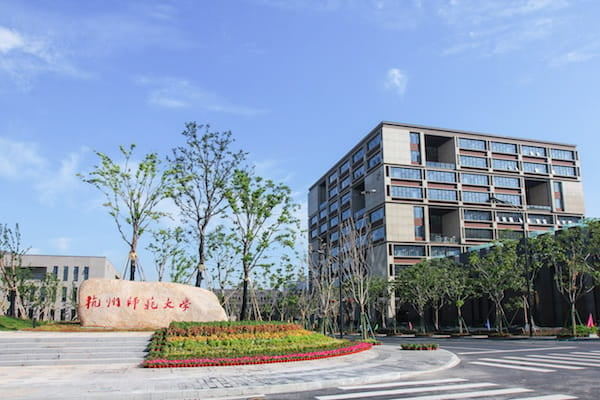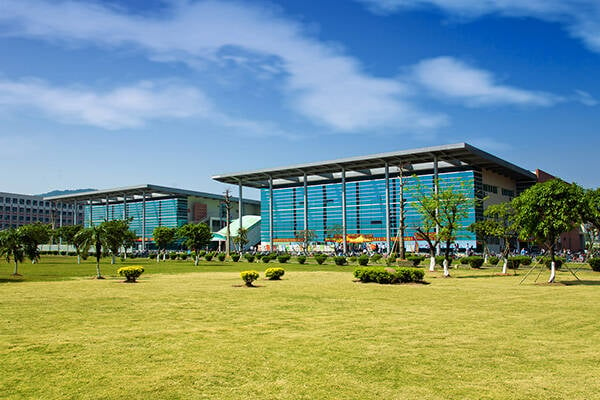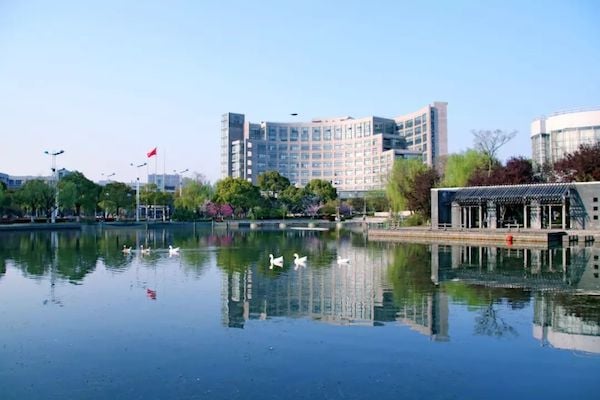 Jiangxi University of Science and Technology
Jiangxi University of Science and Technology

![]()
Introduction to Jiangxi University of Science and Technology
Jiangxi University of Science and Technology (JXUST) was founded in 1958, formerly known as Jiangxi Institute of Metallurgy, renamed Southern College of Metallurgy in 1988, and renamed Jiangxi University of Science and Technology in 2004. The school has been affiliated to the Ministry of Metallurgical Industry and China Nonferrous Metals Industry Corporation. In 2013, it became a university jointly established by the People’s Government of Jiangxi Province, the Ministry of Industry and Information Technology and the Ministry of Education. The school is a unit approved by the State Council with the authority to grant doctoral, master, and bachelor’s degrees. It is a multidisciplinary coordinated development of management, economics, law, literature, art, and education. It is a teaching and research university that has the right to receive overseas Chinese, Hong Kong, Macao, and Taiwan students and foreign students; it is a Baosteel Education Award-accredited university; the school has the qualification to recommend outstanding undergraduates to be exempt from the master’s degree; it is an important talent cultivation in China’s non-ferrous metal industry and steel industry And scientific research base, known as “cradle of non-ferrous metallurgical talents.”
Jiangxi University of Science and Technology has 5 campuses in Ganzhou and Nanchang, covering an area of more than 3,700 acres. The school’s headquarters is located in Ganzhou City, Jiangxi Province, a national historical and cultural city with the reputation of “Tungsten Capital of the World”, “Rare Earth Kingdom”, “Hakka Cradle”, and “Red Old Capital”. The school started undergraduate education in 1958, began graduate education in 1980, and began doctoral education in 2013. There are 1 Department of Materials Metallurgy and Chemistry, 17 teaching colleges and 18 research institutes. There are 33,000 full-time undergraduates and more than 3,000 graduate students. Graduates are widely welcomed by the society for their broad professional adaptability and “honesty, solid foundation, and practical work.” The employment rate and quality of employment have remained at the forefront of universities in Jiangxi, and won the national graduate employment experience in 2011. The “Top 50” of universities in 2017, won the “Top 50” of typical universities of national innovation and entrepreneurship experience in 2017. According to the rankings of CEO graduation schools of China’s “Fortune 500” companies, our school ranked 5th in the 2012 ranking of CEOs of “World 500” companies in China. According to the “China University Rankings” published by the China Alumni Association website, our school ranked 94th in the 2014 “Chinese University Alumni Ranking”.
Jiangxi University of Science and Technology has 1 national model academician workstation, 1 post-doctoral scientific research mobile station, 1 post-doctoral scientific research workstation, 2 first-level discipline doctoral sites (mining engineering, metallurgical engineering), 22 first-level discipline master’s sites, There are 11 professional master’s degree programs, 5 cross-level secondary disciplines, and 4 independent secondary disciplines outside the directory. Among them, “Metallurgical Engineering”, “Mining Engineering” and “Materials Science and Engineering” are three first-class construction disciplines in Jiangxi Province. The overall level of discipline construction is relatively high. Seven first-level disciplines are listed on the national fourth round of disciplinary evaluation results. The school currently has 70 undergraduate majors, of which 65 undergraduate majors are for national enrollment, with 3 national specialty majors, 6 major national outstanding engineer training programs, 12 top-ranked majors in Jiangxi Province, and 1 training base for outstanding legal talents in Jiangxi Province.
Jiangxi University of Science and Technology has established a faculty with a reasonable echelon structure, high academic level, and rigorous academic management. There are more than 2,000 faculty members (including 1390 full-time teachers and more than 600 doctoral teachers). Among them, there is one “Huang Danian-style teacher team” from the Ministry of Education, four academicians from the Chinese Academy of Sciences and the Chinese Academy of Engineering. 1 innovation leader, 1 entrepreneurial leader in the “Ten Thousand People Program”, 4 national candidates for the New Century Multi-Million Talent Project, 1 “863” Chief Scientist, 2 Chinese Academy of Sciences 100 Talent Program (Class A), Ministry of Education One person in the “New Century Excellent Talent Support Plan”, young and middle-aged experts who have made outstanding contributions to the country, more than 60 national model (excellent) teachers who enjoy special allowances from the State Council; “Jinggang Scholars” specially-appointed professors, and “Ganxi Talents 555 Project” leader There are more than 200 talents, academic and technical leaders in major disciplines at the provincial and ministerial levels, famous teachers in Jiangxi Province, candidates for the “New Century Multi-Million Talent Project”, “Jinggang Star” young scientist training targets, and middle and young discipline leaders in colleges and universities. There are more than 700 professors and associate professors, more than 30 doctoral supervisors and more than 400 master supervisors. The school also hired academicians such as Yan Chunhua, Lai Yuanming, Zuo Tieyu, Gu Desheng, Qiu Dingfan, Sun Chuanyao, Zhang Wenhai, and more than 130 well-known domestic and foreign experts and scholars as part-time or guest professors at the school, and employed more than 10 foreign teachers The school teaches year round.
Jiangxi University of Science and Technology owns the National Copper Smelting and Processing Engineering Technology Research Center, the National Engineering Research Center for the Efficient Development and Utilization of Ionic Rare Earth Resources, the Key Laboratory of the Ministry of Education for the Development and Application of Ionic Rare Earth Resources, the Efficient Development and Application Technology of Tungsten Resources A number of national scientific research platforms such as the Engineering Research Center of the Ministry of Education, the National Tungsten and Rare Earth Product Quality Supervision and Inspection Center, 4 national engineering practice education centers, 1 national experimental teaching demonstration center, 1 provincial manufacturing innovation center, There are 3 provincial “2011 Plan Collaborative Innovation Centers”, 1 Haizhi Plan workstation, 20 provincial key laboratories, engineering technology research centers, engineering research centers and key humanities and social science research bases, 8 provincial basic experimental teaching Demonstration centers, 28 experimental centers and 288 internal and external practice bases.
Jiangxi University of Science and Technology has continuously deepened education and teaching reforms, and has won two second prizes for national teaching achievements. Take the lead in piloting the “3 1” innovative education model nationwide, focusing on cultivating students’ practical and practical skills. Students have made major breakthroughs on behalf of colleges and universities in Jiangxi Province in various academic science, technology, and sports competitions at various levels throughout the country and won important honors. In the National University Student Electronic Design Competition and the Mechanical Innovation Design Competition, our students have achieved a breakthrough in the first prize of Jiangxi Province. In the past five years, it has won more than 70 national first prizes in national college mathematics modeling contests, national college mathematics contests, mechanical innovation design competitions, three-dimensional digital innovation design competitions, and robotics competitions. The school aerobics team has won more than one hundred national championships. In the Beijing Olympics cheerleading team trials, it entered the 2008 Beijing Olympics as a champion team. The school climbing team has won more than 20 international and domestic championships such as the International Rock Climbing Masters, the World Cup Climbing Championships and the National Climbing Championships, and has repeatedly broken the world record.
Jiangxi University of Science and Technology actively serves China’s non-ferrous metal industry, iron and steel industry and local economic and social development. It has continuously strengthened discipline construction and scientific research. It has established a group of mining engineering, metallurgical engineering, material engineering, mechatronics, and information technology. Strong disciplines have formed four characteristics and advantages of comprehensive development and utilization of tungsten, copper, rare earth, and lithium resources. Emerging disciplines such as economics, management, science, and law have also become increasingly well-known in China. In the past five years, it has undertaken more than 2000 scientific research projects at all levels, including the National Key Research and Development Plan, the National “863” and “973” Plan, the National Science and Technology Support Plan, the National Natural Science Fund, and the National Social Science Fund, and total research funding of 600 million Diversified; since 2008, he has won 6 second prizes for national scientific and technological progress, two second prizes for national technological inventions, and more than 80 provincial and ministerial prizes, including the first prize for natural science in Jiangxi Province and the first prize for scientific and technological progress. The school’s scientific and technological services have achieved remarkable results, covering 30 provinces, municipalities and autonomous regions throughout the country. For many years, it has worked with more than 100 domestic large and medium-sized steel companies such as China Aluminum, China Steel, Shanghai Baosteel, Jiangxi Copper, Zijin Mining, Tongling Nonferrous Metals, and Western Mining. 2. Non-ferrous metal enterprises have established close production-study-research cooperation relationships, and more than 500 scientific research results have been adopted, which have produced huge economic and social benefits.
Jiangxi University of Science and Technology insists on opening schools and actively expands international exchanges and cooperation. The school implements international joint training programs such as mutual recognition of credits, exchange of undergraduates and students, and cooperative schooling with more than 30 foreign universities such as Lawrenceson University in Canada and Prince Songkhla University in Thailand. The school is a receiving institution for overseas students, and recruits students from 23 countries and regions for language, undergraduate, master and doctoral level studies. The school has been approved as the Chinese Education Base of the Overseas Chinese Affairs Office of the State Council. It has held 20 summer (winter) camp programs and overseas teaching programs, and has taught more than 3,000 overseas students. In 2015, it was approved by Hanban to build a Confucius Institute with the Punjab University of Pakistan. Since its establishment, the Confucius Institute at the University of Punjab has been actively engaged in international promotion of Chinese and the spread of Chinese culture. So far, there have been 6 internal and external teaching sites, 3,391 registered students, 4,528 HSK candidates for Chinese exams, and 33 cultural activities outside the classroom, with a cumulative audience of over 20,000. In 2017, it was approved to cooperate with Punjab University to host a “2 2” undergraduate education in electrical engineering and automation, which is the first overseas Chinese-foreign cooperative school project in the province. The project is provided by the Three Gorges South Asia Investment Co., Ltd. with a full scholarship, and through the order entrusted training mode, it reserves a certain number of localized talents for electric power operation. These students will become the backbone of the construction of the “Belt and Road” and “China-Pakistan Economic Corridor”. In 2018, it was successfully approved by the Ministry of Education for 40 projects in the field of “mining engineering” in Chinese-foreign cooperative education. The school cooperated with Monash University in Australia to establish the “China-Australia 3M International Research Institute of Jiangxi University of Technology”, and established the “Jiangxi University of Technology-University of Queensland High Temperature Process Joint Laboratory” in cooperation with the University of Queensland in Australia, in cooperation with the Offenburg University of Applied Sciences in Germany Established the “Sino-German Industry 4.0 Scientific Research Institute” and “Sino-German Industry 4.0 Talent Education Center”. The school also carried out scientific research cooperation with the University of Queensland, Australia on rare earth technology, Australian high-efficiency grinding and high-efficiency fine particle flotation technology, and undertook a “cooperative research on using DENKA BLACK Li conductive agent to improve the performance of power batteries for electric vehicles” (Japan) More than 10 international scientific and technological cooperation projects, such as “Informatization of Mining Mining” (Zambia), “Research on Gold Extraction Process of Arsenic and Sulfur Refractory Gold Mine” (Myanmar), Chambisi Copper Mine.
![]()
![]()
Related Universities








